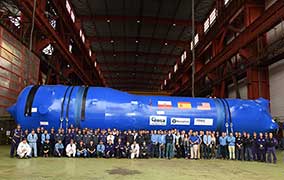ENSA ships four replacement components for the Beaver Valley nuclear plant in Pennsylvania (US)
17 June 2016 | Maliaño

- The parts will arrive to their destination by the end of July, as envisaged
Equipos Nucleares (ENSA) began early this morning to prepare the shipment of four replacement components for the Beaver Valley nuclear power plant in Pennsylvania (US), which is owned by First Energy Nuclear Operating Company (FENOC). Specifically, it consists in three steam generators and one vessel upper head for the second reactor.
In 2005 ENSA already delivered the same set of replacement components for unit no. 1 and, as a result of their good performance and quality, the customer ordered at this company from Cantabria, Spain, the manufacture of the components for its second reactor in August 2012.
Before the end of the useful life of the components of this second reactor, FENOC entrusted Westinghouse with the design of the project, selecting outside ENSA as the company in charge of the purchase of the materials and for the manufacture of all its components, as well as for the tests before the delivery and transport, with the goal of their arriving to their final destination within the deadline set in the contract, that is by the end of July 2016.
A culture of best practices
The Beaver Valley nuclear power plant is among those at the top of the ranking with regard to the culture of best practices in the US, according to the US Nuclear Regulatory Commission (NRC).
In this sense, the Pennsylvania nuclear power plant has required from ENSA the same level of excellence which they themselves have developed in the last few years. A level which the company from Cantabria has already reached and on which it keeps working in order to maintain its good repute in connection with the culture of best practices and Human Performance, which is of the highest priority for ENSA. A quality which the customer has positively assessed.
Those in charge of the project state that the quality of the components is “the highest”, something which has also been recognized by the outside agencies which were responsible of carrying out the tests on the components before their delivery and operation, who had congratulated ENSA for the good quality of the welding and finishes of the components.
Shipment of the components
Once the manufacture ends, the components will be shipped. The process, which began early this morning, will continue until about 12:00 am next Saturday. Once the components are onboard, they will cross the Atlantic until reaching the Gulf of Mexico, and from there tyey will continue to the Mississippi Delta, finally arriving to the plant, which is located by the Ohio River.
ENSA has carried out a detailed study of both the transport by sea and by land to the plant. It has been a delicate work, which has been meticulously performed and on which almost one year and a half have been invested for making sure that it takes place seamlessly, and that all the project ends successfully.
With this project, ENSA consolidates its international record and presence as a multisystem supplier and for large components for nuclear power plants, and expands its participation in the US nuclear industry, to which it has been a supplier for around 40 years.
This record and recognition are based on meeting the highest quality standards and the deadlines which each customer requires for its operating plans.
All of the above is possible thanks to the continuous effort which ENSA applies to the technological improvement of processes and capabilities through its R&D programs, best practices, and continual improvement.
ENSA and Grupo SEPI
ENSA belongs to Grupo SEPI, a corporate holding which includes a total of 16 state-owned companies in which it has direct, majority shareholding participations, with a workforce of around 73,000 professionals in 2014; the Spanish state-owned television and radio corporation, Corporación Radiotelevisión Española, which is attached to SEPI, and one public foundation. Equally, SEPI has direct minority shareholdings in a further ten companies, and indirect shareholdings in more than one hundred companies.







